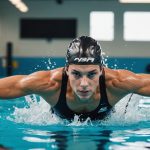Unlock Your Swimming Potential: The 5 Essential Strength-Training Exercises Every Beginner Should Master
Swimming is an excellent way to improve your overall fitness, strengthen your body, and enjoy a low-impact yet effective workout. However, to truly excel in the water, it’s crucial to incorporate strength training into your routine. Here’s a comprehensive guide to help you understand why strength training is vital for swimming and the 5 essential exercises you should master as a beginner.
Why Strength Training is Crucial for Swimming
Strength training is often misunderstood as being solely for bodybuilders or athletes looking to bulk up. However, it is a critical component of any swimming regimen. Here are a few reasons why:
Additional reading : How Air Pollution Influences Your Outdoor Workout: Understanding the Effects on Exercise Routines
General Fitness and Health
Strength training is not just about building muscle; it’s also about improving general fitness and health. It helps in controlling blood sugar levels, reducing inflammation, and enhancing brain health, all of which are beneficial for swimmers.
Injury Prevention
Swimming, like any other sport, comes with its share of injuries, particularly repetitive strain injuries such as shoulder issues or knee problems. Strength training can help strengthen the muscles and surrounding tissues, providing a natural insurance against these injuries. It’s a form of preventive maintenance for your body, much like having travel insurance for your holidays or home insurance for your property.
In the same genre : Unleashing the Power of Recovery: The Ultimate Cooldown Routine for Your HIIT Workouts
Enhanced Performance
Strength training can significantly improve your swimming performance by increasing your muscle power and endurance. This is particularly important for swimmers who need to maintain a high intensity over a long period. By targeting specific muscle groups, you can enhance your stroke efficiency and overall speed in the water.
Understanding Energy Zones in Swimming
Before diving into the specific exercises, it’s important to understand the different energy zones involved in swimming. These zones help coaches and swimmers design workouts that target specific energy systems.
Energy Systems
There are three primary energy systems used in swimming: the phosphagen system, the glycolytic system, and the oxidative system.
- Phosphagen System: This system provides energy for short, explosive movements and is used during sprints.
- Glycolytic System: This system is used for high-intensity activities lasting up to two minutes and results in lactate production.
- Oxidative System: This system is crucial for long-duration activities and relies on the body’s ability to create energy using oxygen.
Training Zones
Understanding these energy systems helps in defining training zones such as the Anaerobic Threshold (AT), Lactate Threshold (LT), Aerobic Endurance (AE), and Maximal Aerobic Speed (MAS).
- Anaerobic Threshold (AT): The point at which muscles switch from aerobic to anaerobic metabolism.
- Lactate Threshold (LT): The intensity at which lactic acid starts to accumulate in the blood.
- Aerobic Endurance (AE): The ability to maintain steady-paced movement over an extended period.
- Maximal Aerobic Speed (MAS): The lowest swimming speed at which maximum oxygen uptake occurs.
The 5 Essential Strength-Training Exercises for Swimmers
Here are five strength-training exercises that every beginner swimmer should master to improve their swimming potential.
1. Upper Body Workout: Push-Ups and Dumbbell Rows
These exercises target the upper body, which is crucial for swimmers. Here’s how to do them:
-
Push-Ups: This exercise strengthens the chest, shoulders, and triceps. Start in a plank position with your hands shoulder-width apart and lower your body until your chest almost touches the ground. Push back up to the starting position.
-
Sets and Reps: 3 sets of 10-12 reps.
-
Tip: Keep your core engaged and your body in a straight line from head to heels.
-
Dumbbell Rows: This exercise targets the back and shoulders. Hold a dumbbell in each hand, bend your knees slightly, and lean forward at the hips. Let your arms hang straight down from your shoulders, then lift the dumbbells to your sides until your elbows are at a 90-degree angle. Lower the dumbbells back to the starting position.
-
Sets and Reps: 3 sets of 10-12 reps.
-
Tip: Keep your back straight and engage your core to support your lower back.
2. Lower Body Workout: Squats and Lunges
A strong lower body is essential for powerful kicks in swimming. Here’s how to do these exercises:
-
Squats: This exercise strengthens the legs, glutes, and core. Stand with your feet shoulder-width apart, then bend your knees and lower your body until your thighs are parallel to the ground. Push back up to the starting position.
-
Sets and Reps: 3 sets of 10-12 reps.
-
Tip: Keep your back straight and your knees behind your toes.
-
Lunges: This exercise targets the legs, glutes, and core. Stand with your feet together, take a large step forward with one foot, and lower your body until your back knee almost touches the ground. Push back up to the starting position and repeat with the other leg.
-
Sets and Reps: 3 sets of 10-12 reps (per leg).
-
Tip: Keep your front knee behind your toes and your back straight.
3. Core Workout: Plank and Russian Twists
A strong core is vital for stability and efficiency in the water. Here’s how to do these exercises:
-
Plank: This exercise strengthens the core, shoulders, and back. Start in a plank position with your hands shoulder-width apart and hold this position for as long as you can.
-
Sets and Reps: Hold for 30-60 seconds, rest for 30 seconds, and repeat for 3 sets.
-
Tip: Keep your body in a straight line from head to heels and engage your core.
-
Russian Twists: This exercise targets the obliques. Sit on the floor with your knees bent and feet flat, lean back slightly, and lift your feet off the ground. Hold a weight or medicine ball and twist your torso to left and right, touching the weight to the ground beside you.
-
Sets and Reps: 3 sets of 10-12 reps (per side).
-
Tip: Keep your core engaged and your back straight.
4. Swimming-Specific Drills: Tombstone Kicks and Vertical Dolphin Kicks
These drills are designed to improve your kicking technique and strength, which are essential for swimming.
-
Tombstone Kicks: This drill improves kicking ability by adding resistance. Place a kickboard in an upright vertical position in front of you, with part of the board submerged underwater. Kick stronger and faster to overcome the drag.
-
Sets and Reps: 3 sets of 25-50 meters.
-
Tip: Lower the board to increase resistance and challenge yourself more.
-
Vertical Dolphin Kicks: This drill develops the up kick and improves core and leg strength. Start with your arms out in front of you or by your side, sculling for support while you kick. Gradually bring your hands and elbows out of the water until you can do it in a vertical streamline position.
-
Sets and Reps: 3 sets of 25-50 meters.
-
Tip: Add weights or fins to increase the challenge.
5. Heart Rate and Endurance Training: High-Intensity Interval Training (HIIT)
HIIT is a great way to improve your lactate threshold and aerobic endurance, both of which are crucial for swimming.
- HIIT Workout: Alternate between high-intensity swimming and low-intensity swimming or rest. For example, swim 25 meters at maximum effort, then rest for 25 meters.
- Sets and Reps: 3 sets of 4-6 intervals.
- Tip: Monitor your heart rate and adjust the intensity based on your lactate threshold and aerobic endurance.
Practical Insights and Actionable Advice
Creating a Balanced Workout Routine
To see significant improvements in your swimming, it’s important to balance your strength training with swimming-specific drills and endurance training.
| Workout Day | Strength Training | Swimming Drills | Endurance Training |
|
|------------------|
|-------------------|
| Monday | Upper Body | Tombstone Kicks | HIIT |
| Tuesday | Lower Body | Vertical Dolphin Kicks | Aerobic Endurance |
| Wednesday | Rest | Rest | Rest |
| Thursday | Core | Head-up Freestyle Drill | HIIT |
| Friday | Upper Body | Breaststroke Pull with Flutter Kicks | Aerobic Endurance |
| Saturday | Lower Body | Backstroke Spin Drill | HIIT |
| Sunday | Rest | Rest | Rest |
Monitoring Your Progress
Use tools like heart rate monitors and swimming analytics to track your progress. Understanding your training zones and lactate threshold can help you optimize your workouts.
Recovery and Nutrition
Recovery is as important as the workout itself. Ensure you get enough rest and consume a balanced diet that includes proteins, carbohydrates, and healthy fats to support muscle growth and recovery.
Unlocking your swimming potential requires a holistic approach that includes strength training, swimming-specific drills, and endurance training. By incorporating these 5 essential strength-training exercises into your routine, you can improve your muscle power, endurance, and overall swimming performance.
As Robert Sapolsky notes, “Exercise simulates a reaction to a stressful emergency which then also triggers the relaxation and recovery mode that follows.” This makes strength training not only beneficial for your body but also for your mental health.
So, dive into your training with a clear understanding of what you need to do to improve your swimming. Remember, every lap you swim and every rep you complete brings you closer to your swimming goals. Happy swimming











